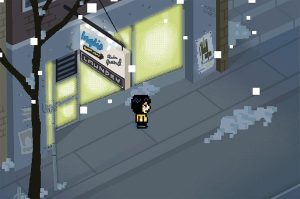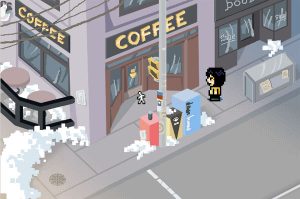A Few Things Artists Can Learn From Indie Game Developers
 Indie gaming is the new gold rush, where anyone has a chance at success with little more than an idea, some basic know-how and an Internet connection. But there’s more to this phenomenon than the cliché of rags to riches. While a handful of indie gamers have hit it big, many others have enjoyed modest success and still others have seen their games disappear into the abyss of the Net. Win or lose, all have had a hand in developing a brand new model for the independent creator. In this model, makers respect and challenge each other while subverting expectations and laying the groundwork for a new kind of culture industry that rewards the creator, not the stockbroker. It’s time for indie artists in other genres to take note: the upstarts of indie gaming are here to stay — and they have a lot to teach us.
Indie gaming is the new gold rush, where anyone has a chance at success with little more than an idea, some basic know-how and an Internet connection. But there’s more to this phenomenon than the cliché of rags to riches. While a handful of indie gamers have hit it big, many others have enjoyed modest success and still others have seen their games disappear into the abyss of the Net. Win or lose, all have had a hand in developing a brand new model for the independent creator. In this model, makers respect and challenge each other while subverting expectations and laying the groundwork for a new kind of culture industry that rewards the creator, not the stockbroker. It’s time for indie artists in other genres to take note: the upstarts of indie gaming are here to stay — and they have a lot to teach us.
Leveling the playing field
With the rise of digital distribution outlets — think iOS, Xbox Live, PlayStation Network, Steam and the web — indie game developers are able to sell their products through the same channels as billion dollar corporations. Using these channels, indies can put their wares in the faces of players who may not specifically seek out indie fare.
“You can be a single person and compete on, say, the App Store with billion-dollar companies for the same attention and dollars,” says Benjamin Rivers, a Toronto web designer, illustrator and game maker. “You can also get thousands or millions of people playing your games, since all you need is (a) a good game and (b) someplace to put it on the Internet.”
Take Minecraft, for example. With a simple focus of getting players to build constructs out of 3D blocks, the popular title by Swedish programmer Markus Persson currently boasts nearly 8 million registered users with well over 2 million people having paid for the game; and one guy made it. Or there’s Cave Story, a free platform-adventure game (basically a jumping puzzle) that was designed in 2004 for PC. After its initial release, Cave Story grew its popularity as an indie game and has since been released on multiple platforms including Nintendo’s WiiWare service in 2010. Seven years after it was designed, Cave Story is still reaching gamers.
There is little denying the impact digital distribution has had on the success of indie gaming.
“Digital distribution was the biggest boon to independent gaming,” says Ryan Henson Creighton, a game developer and founder of Untold Entertainment. “It allowed game developers to decouple from potentially harmful, controlling and predatory publisher relationships and to make and market their games on their own terms.”
Access to these channels is what allowed the free ninja-stickman game N to pass 2 million downloads without the backing of a corporation.
This type of distribution is obviously not the exclusive territory of games. Musicians use the Internet in much the same way and, with the rise of eBooks, independent authors are trending towards digital distribution, too. But no other independent culture genre has been as successful in terms of generating downloads and revenues. Gamers, who were already used to buying online, seamlessly transitioned to indie games, often without even knowing it.
“With media that’s traditionally paper-based, you have an audience that might not be as willing to seek out new content unless it’s on a shelf in front of them,” says Rivers, whose second foot is firmly planted in the comic scene with his graphic novel titles Snow and Empty Words.
The take-away for the rest of us? Going digital creates the potential to reach more eyeballs, but you first need to find the best channel to get it in front of those faces.
Innovation
 But isn’t competing in the realm of major developers such as Rock Star Games and Ubisoft the equivalent of zines sharing the same shelf with mainstream magazines? Way, way, way in the back, a dusty faded zine lies forgotten between stacks of ad-festooned homages to disposable living. Just being there doesn’t necessarily result in sales. That’s where lesson number two comes in.
But isn’t competing in the realm of major developers such as Rock Star Games and Ubisoft the equivalent of zines sharing the same shelf with mainstream magazines? Way, way, way in the back, a dusty faded zine lies forgotten between stacks of ad-festooned homages to disposable living. Just being there doesn’t necessarily result in sales. That’s where lesson number two comes in.
“I think innovation is what drives the indie game scene,” says Tom Rab, president of Winnipeg-based Reborn games. “Some people may say that most indie games are just retro rehashes, but I disagree. While there are a lot of ‘Pixel Art’ games in indie dev, they’re still adding something unique to gameplay or starting something entirely new.”
It goes without saying that indies aren’t going to match corporate competitors when it comes to resources and budget, but by focusing on innovation and creativity, game developers are able to take the chances that larger companies are programmed to avoid.
Take SWEAT, a videogame collective dedicated to making socially conscious games. Started in 2000 by collaborators on both sides of the US-Mexico border, the group now resides in Denver, creating games that attempt to “put players on uncertain footing, without preaching, without piety and open a space, an opportunity for the player to question the situation being presented.” One of the first games created by an early iteration of the collective was Crosser: a variation on Frogger that comments on the issue of illegal immigration by featuring a main character trying to cross the Rio Grande while dodging border guards. Meanwhile, the annual conference Games For Change brings together socially conscious game developers to advocate ways to address pressing issues through gaming.
Sissy’s Magical Ponycorn Adventure is a flash-based adventure game that was built by Creighton, but conceived and designed by his five-year-old daughter, Cassie. The design revolves around Cassie’s crayon drawings and narrative as users navigate her world in search of Ponycorns (unicorn/pony hybrids). Play the game for five minutes and ask yourself if you could ever see a company like Ubisoft allocating resources for a game this unabashedly cute.
Or, how about Superbrothers: Sword & Sworcery EP, an adventure-puzzle-exploration game that has been described as Zelda meets art house cinema. Sworcery started out as an experiment on iOS devices (iPhone, iTouch) and has evolved into something more akin to an interactive film. The newest version, made for the iPad, is rife with heavy cinematic influences and a soundtrack from Jim Guthrie. Sworcery is not easy to categorize as a game, nor is it easy to explain. But it is popular, cracking the Top 25 games in the App Store.
“That’s not to say every game is unique or innovative, but I feel that a lot of indie devs want to make something different, rehashing something that’s been done doesn’t feel creative,” says Rab.
In some ways, indie gaming’s lack of size is its strength. It’s easier to take a risk when there are only a handful of people, or just a single person, involved. And it’s even easier when a lack of resources means you have to do something creative to get noticed. With so much of a game’s buzz built through word of mouth, developers are forced to give people something to talk about: innovate or die.
“This is historically why even larger game companies look to indie games — smaller outfits can afford to innovate and take chances,” says Rivers.
And so Xbox has been looking to Minecraft after its independent success. The game will not only be available on Xbox this fall, it will be complete with Kinect support (controller-less gaming). Message boards have been atwitter since news broke, with most wondering how the game is going to mesh with the Kinect platform. It’s a classic example of a corporate giant tapping into something that started at the most grassroots of levels.
But innovation isn’t limited to how a game is designed. It’s evident in all facets of the culture. Take distribution. A little over a year ago Rab teamed up with fellow developers Alec Holowka, Marlon Wiebe, Kert Gartner and Noel Berry to start the Winnitron Indie Game Arcade Network, a network of arcade consoles that effectively distributes indie games around the world.
“Marlon sparked the idea of an arcade machine that would play indie games; from there it took off,” says Rab. Winnitron went from an idea among friends to four full size old-style arcade cabinets that are stocked with nothing but indie games. Now Canada, the Netherlands, New Zealand and the USA each have a Winnitron arcade machine. An old idea with a twist equals innovation.
Community
 The stated goal of the Winnitron Indie Game Arcade Network is to get game developers to become active members of their local and global independent video game community. Enter lesson number three.
The stated goal of the Winnitron Indie Game Arcade Network is to get game developers to become active members of their local and global independent video game community. Enter lesson number three.
“Indie game developers have a very collaborative nature and a sense of community that seems less common in other [independent culture] industries,” says Mare Sheppard, co-founder of Toronto-based Metanet Software and one of two developers that created N. “In varying degrees, we help each other out with development of our projects, we provide tutorials and code-sharing for each other, we share information and wisdom accrued through experience and we generally don’t see each other as competition,”
The reason indie gaming is more than just a run-of-the-mill success story and possibly something all indie cultures should be paying attention to is its intense sense of community.
Rivers, who has the added perspective of also belonging to the indie comic community, agrees. As he puts it, there are few tortured artists in gaming. “Quit being so sad and alone. Learn to collaborate, meet with people, learn from other folks and share ideas.”
“Networking is one of the most important things you can do as an indie. There’s real power and potential in knowledge-sharing, staying friendly, offering encouragement and cheering each other on,” adds Creighton.
In order to improve their ideas, indie developers have a tradition of releasing early versions of their games to small groups of people as soon as they are playable. Then, taking suggestions from players into account, creators release new updated versions of the game to larger audiences.
“Even if the game may be a bit buggy or features may be missing, this is a good way to find out if the game is fun,” says Rab. “If it’s not fun and you can’t fix it, then you know to toss it aside and start on something fresh.”
If you combine this notion of community with the social nature of the Internet and the digital realm — a realm, it should be noted, that is native to gamers — the results multiply exponentially. Facebook, Twitter, blogs, message boards — for indie gamers these are also forums for getting the word out about a game and places where the community is fostered.
But the gaming community’s relationship is not restricted to the digital sphere. There’s no shortage of opportunities for developers to get out and meet each other. Creighton, for one, attends two international conferences a year. He’s a member of the Hand Eye Society, an indie game dev club. He is on the committee for the Toronto Chapter of the International Game Developers Association. He has attended five Toronto Independent Game Development Jams (ToJam), and often speaks at conferences like the Jalloo Festival of Animation and Gaming, GamerCamp and the Flash Gaming Summit.
ToJam is a three-day event where participants try to create a brand new game in three days. It’s like the 3-Day Novel Contest, except there’s no winner — just a bunch of people in a room making games. At the end of the three days, all the participants have a finished product that they are encouraged to take home and refine. Eventually, these games find their way onto the Internet and we have finished games, distributed digitally, all from an event whose sole purpose is to encourage people to focus. ToJam is a microcosm of what an engaged and participatory culture can accomplish.
And how about that old, indie standard — selling out? How does a culture that makes millionaires out of hobbyist deal with those members who hit the jackpot? Are they kicked out, ostracized for their success? Can games like Minecraft really be considered indie if they generate revenues in the millions and forge partnerships with Microsoft?
“Minecraft was created by an indie developer, and no matter how big Minecraft or any other indie game becomes, the nature of its development will remain constant,” says Sheppard. In other words, let’s stop worrying about who is or isn’t selling out — everyone benefits when an indie goes big, and the popularity of a game hardly changes its fundamental nature.
The indie games boom may eventually wane, but at this moment indie gaming is a culture that thrives on a “take care of our own” attitude. A final and, perhaps, most important lesson worth learning.
